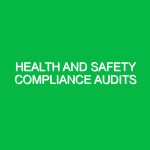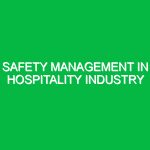In the realm of Health, Safety, and Environment (HSE), the concept of Safe Work Practices for High-Risk Activities stands as a crucial pillar. As industries across the globe engage in activities laden with potential hazards—such as construction, manufacturing, and chemical processing—the need for robust safety measures becomes paramount. These practices not only aim to protect the workforce but also ensure regulatory compliance and operational efficiency. This article will delve into the essence of safe work practices, elucidate the various hazards associated with high-risk activities, and propose actionable precautions to mitigate those risks.
Understanding Safe Work Practices for High-Risk Activities
Safe Work Practices for High-Risk Activities refer to the systematic methods and procedures designed to minimize the risk of accidents and injuries during potentially dangerous tasks. These practices encompass a broad spectrum of measures, from proper training and equipment usage to adherence to regulations and protocols. The relevance of these practices cannot be overstated; they are integral not only for protecting employees but also for fostering a culture of safety within organizations. A well-implemented safety program can substantially reduce workplace incidents, leading to increased productivity and morale.
Identifying Hazards and Risks
High-risk activities are often fraught with various hazards, each presenting unique challenges. Understanding these hazards is the first step in establishing effective safe work practices.
Physical Hazards
These include factors that can cause physical harm, such as machinery, tools, and working at heights. For instance, in construction, workers are often exposed to heavy machinery that can lead to crush injuries if not handled correctly. Moreover, working from ladders or scaffolding poses a significant risk of falls, which are among the leading causes of workplace injuries.
Chemical Hazards
Exposure to harmful chemicals is another critical concern. Many industries utilize substances that can be toxic, corrosive, or flammable. For example, in chemical manufacturing, workers may handle solvents or acids that can cause burns or respiratory issues if proper precautions are not taken.
Biological Hazards
In sectors such as healthcare and waste management, employees may be exposed to biological agents, including bacteria, viruses, or fungi. This exposure can lead to serious health issues, particularly if safety protocols are ignored.
Ergonomic Hazards
These hazards arise from improperly designed workstations or repetitive motions, potentially leading to musculoskeletal disorders. For instance, in warehousing, lifting heavy items without adequate support can result in chronic back pain.
Psychosocial Hazards
While often overlooked, mental health concerns such as workplace stress, harassment, and bullying can severely impact employee well-being and productivity. Creating a supportive work environment is essential for mitigating these risks.
Safety Precautions and Best Practices
Once hazards have been identified, implementing safety precautions becomes essential. Here are several actionable steps that organizations can take to enhance safety in high-risk activities.
Training and Education
A robust training program is the backbone of any safety initiative. Employees must be thoroughly trained on the specific risks associated with their roles and the safe work practices they should follow. For example, a construction company might conduct regular workshops on ladder safety and fall prevention. Engaging employees through hands-on training ensures that they are not only informed but also confident in their ability to work safely.
Personal Protective Equipment (PPE)
Wearing appropriate PPE is non-negotiable in high-risk environments. This includes helmets, gloves, eye protection, and respiratory masks, depending on the nature of the work. It is vital for employers to ensure that employees have access to high-quality PPE and understand how to use it effectively. Anecdotal evidence suggests that in a manufacturing facility where PPE usage was strictly enforced, incidents of injury dropped by over 30% within a year.
Regular Safety Audits and Inspections
Conducting routine safety audits allows organizations to identify potential hazards before they lead to accidents. Inspections should cover equipment, work processes, and compliance with safety protocols. During a safety audit at a chemical plant, for instance, inspectors discovered outdated safety equipment that could have led to catastrophic failures. By addressing this proactively, the plant ensured a safer working environment.
Incident Reporting and Analysis
A transparent incident reporting system encourages employees to report near misses and accidents without fear of reprisal. Analyzing these incidents can uncover patterns and inform further safety measures. For example, a logistics company that implemented a near-miss reporting system was able to identify that most incidents occurred during specific shifts, prompting targeted training and adjustments in staffing to enhance safety.
Emergency Preparedness
Preparedness is key in high-risk environments. Organizations should develop and regularly update emergency response plans, ensuring that all employees are familiar with evacuation routes, first aid procedures, and emergency contacts. Drills should be conducted to reinforce these protocols. A healthcare facility that practiced emergency evacuation drills multiple times a year found that response times improved significantly during actual emergencies, showcasing the value of preparedness.
Regulations and Standards in Safe Work Practices
Understanding the legal framework surrounding safe work practices is crucial for compliance and risk management. Various regulations govern safe work practices, and organizations must familiarize themselves with these guidelines to remain compliant.
Occupational Safety and Health Administration (OSHA)
In the United States, OSHA sets forth regulations that employers must adhere to in order to ensure workplace safety. These regulations cover everything from fall protection to hazardous material handling. Employers are required to provide a safe working environment and to train employees on the risks associated with their jobs.
International Standards Organization (ISO)
ISO standards, such as ISO 45001, provide a framework for occupational health and safety management systems. This standard helps organizations improve employee safety, reduce workplace risks, and create better working conditions. Companies that adopt ISO standards often see an improvement in their safety culture, leading to fewer incidents over time.
National Institute for Occupational Safety and Health (NIOSH)
NIOSH conducts research and makes recommendations to prevent work-related injuries and illnesses. They provide valuable resources for organizations seeking to enhance their safety practices by offering guidelines and best practices across various industries.
Conclusion: A Commitment to Safety
Safe Work Practices for High-Risk Activities are not merely regulatory requirements; they represent a commitment to the welfare of employees and the integrity of operations. By identifying hazards, implementing effective safety precautions, and adhering to established standards, organizations can cultivate a safer workplace. This not only protects workers but also enhances productivity and fosters a positive organizational culture. Ultimately, investing in safety is an investment in the future—one where employees can thrive in secure and healthy environments.


